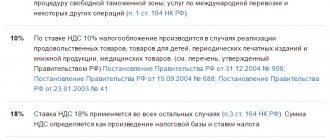Federal Law No. 382-FZ of November 29, 2014 “On Amendments to Parts One and Two of the Tax Code of the Russian Federation” supplemented Article 172 of the Tax Code with a new clause 1.1, which came into force on January 1 of this year. According to the norm, companies have the right to claim tax deductions provided for in paragraph 2 of Article 171 of the Tax Code within three years after registering goods (work, services) and property rights purchased on the territory of the Russian Federation or imported into the country.
Let me remind you that for a long time the official position of the Ministry of Finance and the Federal Tax Service on the procedure for applying the right to deduct VAT was as follows: tax amounts can be deducted in the period in which the company acquired the right to it. The department believed that this could not be done later. If the company applied the deduction in subsequent periods, it had to file an amended return for the time when the right to apply the deduction arose. Moreover, on the basis of paragraph 2 of Article 173 of the Tax Code, the organization could submit a declaration within three years after the end of the quarter in which it acquired the specified right (Letters of the Ministry of Finance dated March 12, 2013 No. 03-07-10/7374, dated February 13, 2013 No. 03-07-11/3784, dated January 15, 2013 No. 03-07-14/02, dated October 31, 2012 No. 03-07-05/55, dated October 13, 2010 No. 03- 07-11/408, Federal Tax Service dated March 30, 2012 No. ED-3-3/ [email protected] ).
On a note
The Ministry of Finance explained that a business has the right to deduct VAT on the basis of one invoice in parts in different tax periods. Merchants can do this within three years after registering goods, with the exception of fixed assets, equipment for installation and intangible assets.
However, the Presidium of the Supreme Arbitration Court of the Russian Federation has repeatedly stated that Chapter 21 of the Tax Code does not contain a prohibition on deducting VAT outside the tax period in which such a right arose. Therefore, the deduction can be applied later, subject to the three-year deadline (Resolutions of November 22, 2011 No. 9282/11, of June 15, 2010 No. 2217/10 and of June 30, 2009 No. 692/09).
In Resolution No. 33 of May 30, 2014, the Plenum of the Supreme Arbitration Court indicated that firms have the right to take advantage of deductions at a later period within three years after the end of the quarter in which the right to deduction arose (clauses 27, 28 of the Resolution).
Now, from January 1, there is no need to submit a “clarification”. Companies have the right to independently choose the period for claiming the deduction.
In addition, the Ministry of Finance explained that a business has the right to deduct VAT on the basis of one invoice in parts in different tax periods. Merchants can do this within three years after registering goods (work, services), with the exception of fixed assets, equipment for installation and (or) intangible assets (Letters dated April 9, 2015 No. 03-07-11/20293, dated May 18, 2015 No. 03-07-RZ/28263).
However, despite the amendments to Article 172 of the Tax Code, companies still have many questions. How will tax authorities determine the three-year limitation period during inspections, taking into account Law No. 382-FZ that has entered into force? Let's take a closer look at this.
Define period
In accordance with paragraph 1 of paragraph 1 of Article 172 of the Tax Code, tax deductions provided for in Article 171 of the Tax Code are made on the basis of invoices issued by sellers when the company purchases goods (works, services), property rights, documents confirming the actual payment of tax amounts when importing goods to the territory of the Russian Federation and other territories under its jurisdiction, papers confirming the payment of VAT amounts withheld by agents.
Money can be accepted for deduction only after the products are reflected in the company’s accounting, and if the relevant primary documents are available (paragraph 2, paragraph 1, article 172 of the Tax Code of the Russian Federation). Another mandatory condition is the use of purchased goods (works, services), property rights in the activities of the organization (clause 2 of Article 171 of the Tax Code of the Russian Federation).
On a note
VAT first appeared in 1958 in France. Currently, value added tax exists in more than 100 countries around the world. However, some states have abandoned it, for example, in the USA it is absent; instead of VAT, the buyer pays, and the seller transfers sales tax to the budget.
As for the period in which these amounts can be declared for deduction, in accordance with paragraph 1.1 of Article 172 of the Tax Code, this is allowed within three years after the registration of goods (works, services), property rights acquired by the company in the territory of the Russian Federation (Letter of the Ministry of Finance dated February 12, 2015 No. 03-07-11/6141).
Based on the provisions of Article 163 of the Tax Code, the VAT tax period is equal to a quarter. For example, an organization purchased and registered goods in May 2015. Therefore, the three-year period must be counted from the moment at which the company acquired the right to apply the deduction, that is, from the next day after June 30.
Therefore, the three-year period in which a company can take advantage of the VAT deduction expires on June 30, 2021. In other words, an organization has the right to declare a deduction in one of the tax periods starting from the third quarter of 2015 and ending with the second quarter of 2018.
If the OS will be used in VAT-free transactions
If a fixed asset is acquired for use only in transactions not subject to VAT, then VAT on this fixed asset is taken into account in the cost of the fixed asset in both accounting and tax accounting (clause 8 of PBU 6/01, clause 2 of Article 170, clause 1 Article 257 of the Tax Code of the Russian Federation). And when using fixed assets in both non-taxable and VAT-taxable activities, the input tax on it will need to be divided using separate accounting: into those accepted for deduction and taken into account in the cost of the fixed assets. In the accounting policy, it can be established that input VAT is divided already in the month the asset is accepted for accounting. And then you won’t have to wait until the end of the quarter to calculate the amount of tax accepted for deduction (clause 1, clause 4.1, article 170 of the Tax Code of the Russian Federation).
When purchasing an OS
According to paragraph 2 of Article 171 and paragraph 1 of Article 172 of the Tax Code, VAT amounts presented when purchasing goods (work, services) on the territory of the Russian Federation are subject to deductions if they are purchased for taxable transactions. You can use this right after the OS has been registered and in the presence of invoices issued by sellers. At the same time, according to the position of the Ministry of Finance, the company has the right to do this after registering fixed assets, equipment for installation and (or) intangible assets in full (Letters dated April 9, 2015 No. 03-07-11/20293, dated May 18, 2015 No. 03-07-RZ/28263).
Deduction from advances
According to paragraph 12 of Article 171 of the Tax Code of the Russian Federation, a company that has transferred the amount of payment, including partial, on account of upcoming deliveries of goods (performance of work, provision of services), transfer of property rights, has the right to deduct the amount of tax presented by the seller. Let us pay attention to the provisions of paragraph 9 of Article 172 of the Tax Code. According to the norm, an organization for this will need invoices issued by sellers upon receipt of payment, partial payment for upcoming deliveries, transfer of property rights, as well as documents confirming the actual transfer of money, an agreement providing for the transfer of these amounts. In this case, the right of companies to claim deductions for three years is not secured in the Tax Code. Therefore, this can be done in the tax period in which the organization fulfilled the conditions provided for in Articles 171 and 172 of the Tax Code (Letter of the Ministry of Finance dated April 9, 2015 No. 03-07-11/20290).
EXAMPLE Accept for deduction of fixed assets An organization acquired a fixed asset on January 10, 2015, put it into operation and registered it as a fixed asset on April 10, 2015. From what point do you count three years for the OS deduction? According to the Ministry of Finance, set out in Letters No. 03-07-11/19 dated January 24, 2013, No. 03-07-11/290 dated October 28, 2011, deductions of VAT amounts presented by sellers to the taxpayer when purchasing fixed assets are made in full volume after registration of OS. However, Chapter 21 of the Tax Code does not connect this point with the reflection of assets on any specific accounting accounts: on account 01 “Fixed assets” or 07 “Equipment for installation” and 08 “Investments in non-current assets”. The courts recognize the legality of deducting VAT after reflecting the asset on account 08. Consequently, the first tax period in which the company has the right to take advantage of the deduction is the second quarter of 2015. Thus, the three-year period must be counted from the moment at which the organization acquired the right to apply a tax deduction, that is, from the next day after March 31, 2015. It expires on March 31, 2021. In other words, an organization has the right to declare a deduction in one of the tax periods starting from the second quarter of 2015 and ending with the first quarter of 2021. However, if we follow the position of the Ministry of Finance, these terms will be different: from the third quarter of this year to the second quarter of 2021.
Thus, if a company accepted a deduction after the tax period in which the right to it arose, it must submit a “clarification” to the inspectorate. Moreover, on the basis of paragraph 2 of Article 173 of the Tax Code of the Russian Federation, the company has the right to file such a declaration within three years after the quarter in which this right arose (Letters of the Federal Tax Service dated March 30, 2012 No. ED-3-3 / [email protected] , Ministry of Finance dated October 13, 2010 No. 03-07-11/408, dated June 22, 2010 No. 03-07-08/186, Determinations of the Supreme Arbitration Court of the Russian Federation dated February 3, 2010 No. VAS-113/10, dated May 17, 2011 No. VAS-5739/11).
From the explanations of the Plenum of the Supreme Arbitration Court, set out in paragraph 27 of Resolution No. 33 of May 30, 2014, it follows that the positive difference resulting from the excess of the amount of deductions over the amount of tax calculated on taxable transactions is subject to reimbursement from the budget. However, to do this, the organization must submit a declaration before the expiration of the three-year period established by paragraph 2 of Article 173 of the Tax Code. Since this norm does not provide otherwise, deductions can be reflected in the declaration for any of the tax periods included in the corresponding three-year period.
At the same time, the “three-year” rule must also be observed in the case of including deductions in the submitted declaration. In addition, please note that VAT on advances paid may not be deducted at all (Letters of the Ministry of Finance dated April 12, 2013 No. 07-01-06/12203, dated September 1, 2009 No. 03-07-14/92) .
VAT refund 2021: briefly about the important
The tax authority has 2 months to verify the declaration.
2 p. 2 art. Tax Code of the Russian Federation). If the exporter sells not goods, but works or services, then the input value added tax can be deducted (new subclause
But if inspectors find signs indicating possible errors and violations, the desk audit of the VAT return can be extended up to three months based on the decision of the head (deputy) of the Federal Tax Service (clause 2 of Article 88 of the Tax Code of the Russian Federation). If no violations are found, the tax authority makes a decision on compensation within 7 working days after completion of the audit.
In this case, the period for the actual tax refund will depend on the moment you submit your application for a refund:
- If such an application is submitted before a decision on a refund is made, for example, together with a VAT return, then the inspectorate will have to make a decision on a refund (offset) simultaneously with the decision on a VAT refund. The next day, she will send an order to the treasury for a tax refund, and the treasury will return the tax within five working days to the taxpayer’s account (clauses 7 and 8 of article 176 of the Tax Code of the Russian Federation).
- if the application is submitted after the decision on compensation is made, then the inspectorate will have another month to return it (clause 11.1 of Article 176 of the Tax Code of the Russian Federation).
Now there is also the possibility of an accelerated VAT refund, before the completion of the verification of the declaration - on the basis of the application procedure (Article 176.1 of the Tax Code of the Russian Federation). Only taxpayers who meet certain requirements can take advantage of this opportunity, including the total amount of taxes paid over the last 3 years (at least 2 billion).
rub.), or subject to the provision of security in the form of a bank guarantee or surety from a “very respectable” taxpayer. The surest way to avoid problems and make the VAT refund procedure as comfortable as possible is to turn to professionals.
have many years of experience in supporting VAT refunds.
They will help you in creating a set of documents and interacting with the inspectorate, and will competently guide you through all stages of VAT refund.
Another indulgence?
The innovations in Article 172 of the Tax Code of the Russian Federation are yet another concession for business. However, from January 1, 2015, companies that were previously accustomed to using the “transfer” of VAT deductions run the risk of losing in court. The fact is that before this date, the code did not establish a lower limit for the three-year period during which companies could apply the deduction by either filing an amended declaration or reflecting the amount of the deduction in the declaration for the reporting period. Since before January 1, 2015, the start date for calculating this period was not regulated, the Ministry of Finance, the Federal Tax Service and arbitration courts believed that it should be calculated from the moment all conditions for applying the deduction are met. Now, paragraph 1.1 of Article 172 of the Tax Code clearly states that the deductions provided for in paragraph 2 of Article 171 can be claimed within three years after goods (work, services) and property rights are registered. That is, now the date is clearly defined, and there can be no discrepancies.
Irina Razumova
, for the magazine "Calculation"
Help your business grow
Invaluable experience in solving current problems, answers to complex questions, specially selected latest information in the press for accountants and managers. Choose from our catalog >>
If you have a question, ask it here >>
Adjustment or corrected invoice?
According to paragraph 3 of Article 168 of the Tax Code of the Russian Federation, if the cost of shipped goods (work performed, services rendered) or transferred property rights changes, including in the event of a change in price and (or) clarification of the quantity (volume) of shipped goods (work, services), the seller issues to the buyer adjustment invoice. This must be done no later than 5 calendar days, counting from the date of drawing up the documents specified in paragraph 10 of Article 172 of the Tax Code of the Russian Federation.
These include: a contract, agreement, other primary document confirming the buyer’s consent (fact of notification) to a change in cost due to an adjustment in price and (or) quantity (volume) of goods (work, services) shipped.
That is, in order to issue an adjustment invoice, the buyer’s consent, documented, is required.
If these conditions are met, then VAT adjustments are made by the seller and buyer in the current period by registering an adjustment invoice in the purchase or sales ledger. Updated declarations for previous periods are not submitted.
The VAT consequences of receiving a corrected invoice are completely different:
- The buyer must cancel the incorrect invoice in the additional list of the purchase book for the previous tax period, submit an updated VAT return with a reduction in the amount of tax deductions, paying additional tax and penalties if necessary.
- File a corrected invoice for the current quarter, claiming the tax deduction in the correct amount. Similar clarifications were given by the Federal Tax Service of Russia regarding the corrected invoices and the universal transfer document (Letter No. GD-4-3/7593 dated 04/21/2014 (on issue 2).
Thus, the procedure for transferring tax deductions to later periods contains many features. As a general rule, tax can be deducted in any quarter within 3 years. But it is always necessary to take into account the private rules of the Tax Code of the Russian Federation established for deductions for specific transactions.







